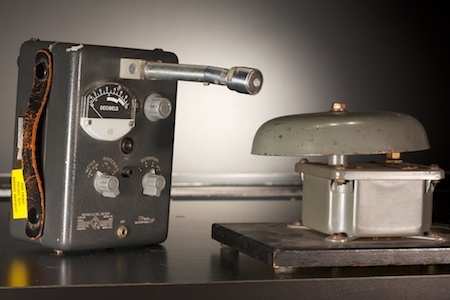Sound pressure level of a fire bell decreases by 6dB when distance is doubled.

What It Shows
The intensity of sound waves emanating from a point source changes inversely as the square of the distance from the source (for an example using visible light, see Inverse Square Law). Although this may be a straightforward concept, the illustration of this phenomenon through casual measurement can be tricky, as interference and reflection effects can easily complicate observations. If done properly the method described here gives a reasonably convincing illustration of the relationship between intensity and distance.

How It Works
To show this relationship we use a fire bell as a sound source whose intensity is measured and then calculated in terms of sound pressure level. The fire bell is placed flat on a moveable cart and can be struck at about 30 Hz when the inline switch supplies current to the driver. A microphone is placed on the lecture bench and tape can be placed on the floor to mark 1m and 2m distances. The root mean square of the amplitude of the voltage signal from the microphone gives the intensity I, and the sound pressure level SPL is calculated by the following formula:
SPL = 10dB*log10(I/Io)
where Io is a reference level corresponding to about 20μPa—also known as the threshold of human hearing. From here we can see that a change in Iby a factor of four will result in a 6dB change in SPL.
Setting It Up
We currently have two devices for measuring SPL.
The analog device1 is battery operated and has a built-in microphone. The SPL is read instantly as a needle deflection, so a camera with a short lens should be set up in front of the device. Start with the dB range at 100 and adjust as necessary; time-weighting set to slow; frequency-weighting set to C. With the bell ringing, the reading will fluctuate a little (even if the time-weighting is set to slow), so the presenter should judge the average reading over a period of 5 to 10 seconds.
The digital device2 has both an LCD readout and a cable to send data to LoggerPro. As with the analog device, set the dB range to 100, time-weighting to slow, and frequency-weighting to C. The device can also be set to display only the maximum level instead of the instantaneous level.
Standing next to the ringing bell, the presenter will experience an SPL of about 110dB, so over-the-ear hearing protection should be worn to prevent hearing damage. Students in the front rows should be encouraged to cover their ears. While taking measurements, the presenter should stand parallel with the bell and move very little so as to prevent unwanted interference.
Comments
The fire bell will certainly get the attention of the class—and neighboring classes! We have found that the bell works reasonably well as a point source. Alternately, it is possible to use a small speaker connected to a signal generator, although you may have to fuss with the volume and distance in order to acheive consistent results.
References
1. Sound Level Meter Type 1551-B Ser No 1032 General Radio Co. Concord, MA.
2. Sound Level Meter Order Code SLM-BTA Vernier Software & Technology Beaverton, OR.